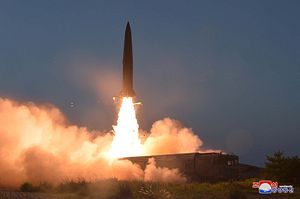North Korea is back at it again. On July 25, it launched two more ballistic missiles, which from released images appear to be the same new short-range, single-stage, solid-fuel missiles tested in May.
The U.S. intelligence community calls this missile the KN23 and North Korea, per its release after the test, still calls the system its “new-type short-range” ballistic missile. While the parameters of the launch exhibited interesting characteristics compared to the May launches—most notably a longer range of some 600 km each—the reason North Korea conducted these launches is notable.
First of all, the launches come a little more than 3 weeks after the historic June 30 summit between U.S. President Donald J. Trump and North Korean leader Kim Jong Un at the inter-Korean Demilitarized Zone. The goodwill from that summit is quickly evaporating.
The Korean Central News Agency’s readout on the July 25 test, released a day later, made no direct mention of the United States. Rather, it focused energies on South Korea. It described the tests as a “solemn warning to the belligerent forces of the South Korean military.”
Why is Kim Jong Un swiping out at the South Korean military? The reasons as stated by the North Korean release include the Moon administration’s decision to press ahead with military exercises with the United States and Seoul’s ongoing deliveries of F-35A Panther stealth fighters.
The Dong Maeng 19-2 exercise is scheduled begin between the United States and South Korea in August. The exercise is slated to be a lower-intensity successor to the old late-summer Ulchi-Freedom Guardian computerized command post exercises.
North Korea made its displeasure about these exercises known earlier in the month when a Foreign Ministry spokesperson bristled at the exercises, pointing out that Trump had promised Kim during the June 30 summit that the upcoming drills would be canceled. U.S. officials have not shed clarity on the issue, as I discussed recently here in The Diplomat.
The F-35A issue, meanwhile, was not picked up by major international media before the latest exercises. On July 11, a statement attributed to the Institute for American Studies within the North Korean Ministry of Foreign Affairs suggested that Seoul taking delivery of two additional F-35As earlier in July was sufficient reason to “develop and test special armaments.”
The acute cause of the latest test, then, would be the F-35A deliveries to South Korea. But the broader context regarding the upcoming military exercises remains salient as well.
North Korea regards advanced aerial stealth platforms like the F-35A and the U.S. B-2 strategic bombers with particular disdain given its aging air defense radars. This time, it chose to demonstrate its displeasure by testing a new type of short-range ballistic missile that would be capable of holding South Korean airfields at risk.

































